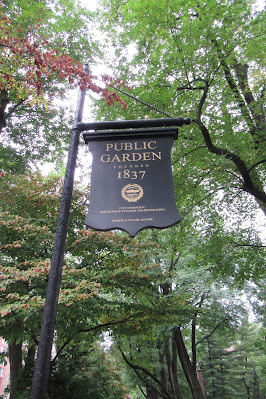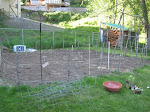Hurricane Ian was just on it's way back out to sea when we arrived in Boston, making for a wet first day. We took the subway into town and started the day with the Old Town Trolley Tour through Boston. Like always, the hop-on-hop-off tours are a great way to get an overview of a city and hear a bit of history and information about wherever you are. With the rain cover down and rain coming down, we didn't get any pictures from the trolley. But it was a really good tour.
After the about 2 hour tour, we hopped off at the Boston Public Garden stop for a walk through the park and an early bite to eat at Cheers, "where everybody knows your name."
No famous swan boats but the lagoon was still pretty
Make Way For Ducklings was published in 1941 about ducklings
raised on an island in the lagoon (Mrs. Mallard and Jack, Kack, Lack, Mack, Nack, Ouack, Pack, and Quack)
Nobody knew our name but it was still a fun first stop and a great place to enjoy and beer before hitting The Freedom Trail.
The actual pub Cheers was based on
A mock-up of the tv set in the museum upstairs
While not an official stop on the Freedom Trail, we had to stop to see the Robert Gould Shaw and the 54th Regiment Memorial. It was unveiled in May1897 to commemorate the 54th Regiment's role in leading the assault on Fort Wagner on July 18, 1863. Over half of the 600 men were killed, captured or went missing. It is the story of one of my favorite movies, Glory.
The Freedom Trail is easy to follow along the 2.5 miles thanks to the red brick line along the sidewalk.
Stop #1- Boston Common
"Boston Common is America's oldest park, purchased from William Blackstone in 1635 to be used as common grazing land for the 'feeding of cattell.' The British militia used it as a 'traying field.' The Common has also been the site of hangings, duels, public celebrations and spirited oratory. Today it continues to host public celebrations, as well as concerts, Shakesperean plays, ice-skating, holiday festivities, sports activities and public rallies."
Stop #2 - Massachusetts State House
"Designed by Charles Bulfinch, the State House was completed in January 1798 at a cost of $133,333 (more than five times the budget). John Hancock, a wealthy merchant, patriot, signer of the Declaration of Independence and the first elected governor of Massachusetts originally owned the land. The oldest building on Beacon Hill is know the seat of Massachusetts state government. The golden dome, one of Boston's distinguishing landmarks, wasn't always gilded. It was originally built of wood. Paul Revere & Sons was commissioned in 1802 or cover it with copper to prevent water leakage. In 1874, the dome was gilded with 23-karat gold leaf."
Stop #3- Park Street Church
"Park Street Church acquired the nickname 'Brimstone Corner', both in reference to the fire-and-brimstone sermons and to the gun powder that was stored in the crypt during the War of 1812. Founded in 1809, the Church's 217-foot white steeple was the first landmark a traveler saw upon approaching Boston. On July 4, 1829, abolitionist William Lloyd Garrison gave his first public anti-slavery address here, and two years later, on July 4, the hymn America, better known as My Country Tis of Thee, was first sung on the Church steps."
Stop #4- Granary Burying Ground
"So named because of its proximity to Boston's first granary, this is the most visited burial ground in Boston and the final resting place of many prominent Bostonians. Buried here are John Hancock, Samuel Adams, eight governors, all five Boston Massacre victims, Paul Revere, Ben Franklin's parents, Peter Faneuil, and possibly Mother Goose."
While I didn't get pics of all the famous headstones, I did take a lot of pictures of cool old headstones...
Then it was across the street to the Beantown Pub for Boston baked beans, brown bread and the very old Sam Adams joke...
Yes, we did enjoy both 😝
Stop #5- King's Chapel & Burying Ground
"Under orders from King James II in 1686, land was seized and the first Anglican Church was constructed. By 1749, the original wooden structure was too small for the congregation, and so the Georgian chapel was constructed around the original church. Slaves sat in the rear gallery on the cemetery side and condemned prisoners sat to the right for a last sermon before being hanged on the Common. In 1785, King's Chapel became the first Unitarian Church in America. The canopied Governor's Pew was used not only by the royal governors, but also by President Washington on his 1789 visit to Boston.
Adjacent to King's Chapel is Boston's first burying ground. Here you will find the graves of John Winthrop, Massachusetts' first govenor; William Dawes, Paul Revere's compatriot who also made the ride to Lexington, and Mary Chilton, believed to be the first woman to step off the Mayflower."
Here you will also see a whole lot more gravestone pictures... LOL
This is actually a subway vent
Then we wandered back to the Omni Parker House for a mini Boston Cream Pie. Yum!
"Boston's oldest and the longest continuously operating hotel in the country. During its 150-year history guests have included the 19th century literary Saturday Club, Babe Ruth, Ted Williams, Presidents Grant, Roosevelt, and Kennedy, Sarah Bernhardt, John Wilkes Booth, and Charles Dickens. Ho Chi Minh worked in the bakeshop and Malcolm X in the dining room. Boston Cream Pie, the Parker House Roll, and according to local legend, the term 'scrod' all originated here as well."
Yes, I had to look up what scrod was. Turns out it's the smallest weight of whitefish like cod or haddock.
Stop #6- First Public School Site
"Embedded in the sidewalk in front of Old City Hall is the mosaic City Carpet, which commemerates the site of the first public school in the US, Boston Latin School (1635). Among the school's illustrious alumni are Ben Franklin, John Hancock, Samuel Adams, Charles Bulfinch, and Ralph Waldo Emerson. The school continues to operate today at another location; admission is by competitive exam; four years of Latin are still required; and girls were admitted in 1972.
Richard Greenough's statue of Ben Franklin, erected in 1856, prominently stands in front of Old City Hall. Look closely at Franklin's face. The sculptor said that he found the 'left side of the great man's face philosophical and reflective and the right side funny and smiling.'"
Stop #7- Old Corner Bookstore
"The original building on this site was the home of Anne Hutchinson, who was banished from Massachusetts in 1638 for her unorthodox religious views. By the mid-1800s, the Old Corner Bookstore was a flourishing literary center. Here, Ticknor and Fields, the nation's leading publisher from 1833 to 1864, published works by Dickens, Harriet Beecher Stowe, Tennyson, Hawthorne, Emerson, Longfellow, Oliver Wendell Holmes, Elizabeth Barrett Browning and Julia Ward Howe among others. The Atlantic Monthly, a Boston institution, was originally published here as well."
Now it's a Chipolte...
Nearby is the Irish Famine Memorial...
"... commemorates the 150th anniversary of the Irish Famine, where over 1 million died and over 100,000 Irish immigrated to Boston."
Stop #8- Old South Meeting House
"Built in 1729, this is the second oldest church in Boston. The largest building in colonial Boston, Old South was used for public meetings when the angry crowd outgrew Faneuil Hall. Many of the crucial events that led up to the Revolution took place here. The most famous of the meetings was held on December 16, 1773, when over 5,000 gathered to protest the tax on tea. During the British occupation of Boston in 1775-1776, British troops dececrated this sanctuary of freedom by using it as a stable and riding school, while drinks were served from the balcony. The pulpit and pews were chopped into firewood and the library was used as kindling."


















































No comments:
Post a Comment